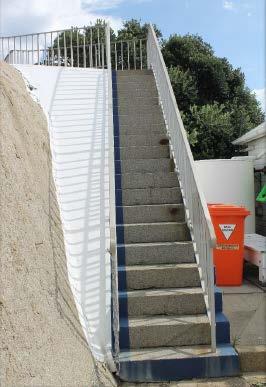4.1 Fabric register
The cultural significance of the Montague Island Lighthouse resides in its fabric, and also in its intangible aspects, such as the meanings people ascribe to it, and its connections to other places and things. The survival of its cultural value depends on a well-informed understanding of what is significant, and on clear thinking about the consequences of change. The Burra Charter sets out good practice for conserving cultural significance. Criterion under ‘Heritage Significance’ refer to the criterion satisfied within the specific Commonwealth heritage listing (see section 5.1).
Lighthouse feature: Lantern roof
Description and condition
1880 Chance Bros part-spherical dome of copper sheets lapped and screwed to ribs.
- Ribs – Chance Bros cast iron radial ribs
- Inner skin – none (removed)
- Ventilator – ball type with wind vane attached
- Lightning conductor – vertical pole mounted on dome, with four spikes at top, and two braces to roof sheets, eight vertical spikes attached near the gutter.
- Gutter – circular ring of cast iron pieces bolted together. Drawings indicate the lantern roof may have been overhauled around 1981.
- Ladder rail – attached to underside of gutter.
- Drip tray – copper dish suspended under ventilator, with central hole for heat tube.
- Heat tube support – framework with four radial members of rolled ferrous T-section, attached to gutter and to central ring
Finish: painted
Condition: intact and sound
Integrity: high
Significance: high
Maintenance: keep in service; prepare and repaint at normal intervals
Rectification works: none
Heritage significance: High
The lantern roof is both an original and essential part of the lighthouse, exhibiting one style of late-19th century lighthouses (criterion a, criterion d).
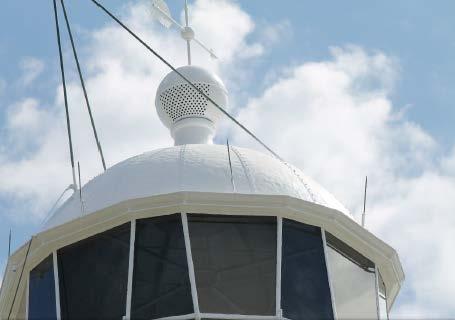
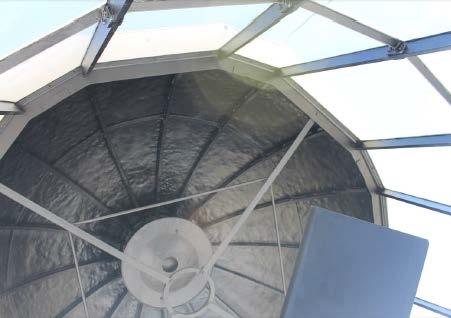
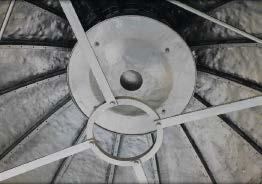
Lighthouse feature: Lantern glazing
Description and condition
Chance Bros, polygonal in plan.
- panes – flat trapezoidal glass, three tiers.
- astragals – Chance Bros vertical and horizontal.
- astragals of rectangular and triangular section, bolted to gutter ring at top, and to lantern base below.
- downpipes – two short spitters inserted in bottom of gutter. Downpipes have been removed.
- handholds – two sets, fixed to cover strips.
Finish: astragals and glazing strips painted
Condition: intact and sound
Integrity: high
Significance: high
Maintenance: keep in service; reglaze as necessary, prepare and repaint at normal intervals
Rectification: works none
Heritage significance: High
The lantern glazing is an essential part of the lighthouse – exhibiting one style of late-19th century lighthouses (criterion a, criterion d).
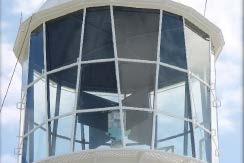
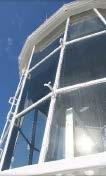
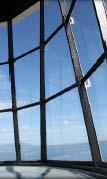
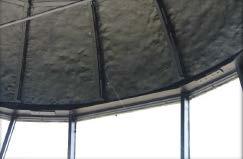
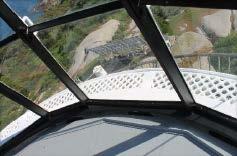
Lighthouse feature: Internal catwalk
Description and Condition
Original catwalk decking removed and replaced with a new floor supported on the original openwork cast iron brackets bolted to the upper section of the lantern base.
- floor – sheet flooring in segments, supported on pre-fabricated aluminium radial beams and cross beams, supported on the original iron brackets on the outside, and on a fabricated steel column in the middle
- ladder – fixed aluminium ladder
Finish: painted
Condition: intact and sound
Integrity: medium
Significance: high
Maintenance: keep in service, prepare and repaint at normal intervals
Rectification works: none
Heritage significance: High
Highly significant for these reasons:
- The internal catwalk is an original and essential part of the lighthouse (criterion a).
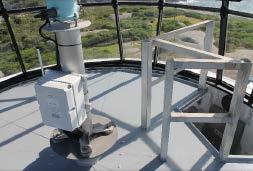
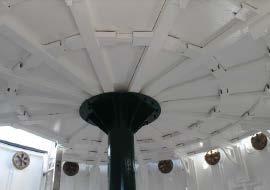
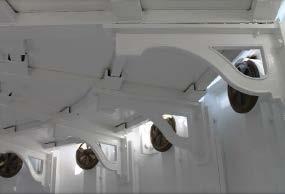
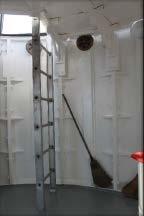
Lighthouse feature: External catwalk
Description and condition
1880 Chance Bros, cast iron lattice floor panels supported on openwork cast iron brackets bolted to lantern base with modern socket-head bolts.
- handrail – none
Finish: painted
Condition: intact and sound
Integrity: high
Significance: high
Maintenance: keep in service, prepare and repaint at normal intervals
Rectification: works none
Heritage significance: High
The external catwalk is both an original and essential part of the lighthouse – exhibiting one style of late-19th century lighthouses (criterion a, criterion d).
The external catwalk contributes to the aesthetic value of the lighthouse (criterion e).
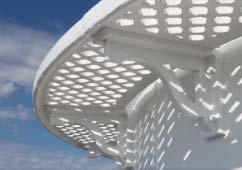
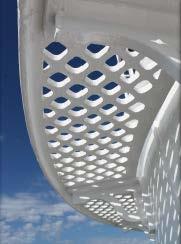

Lighthouse feature: Lantern base
Description and condition
1880 Chance Bros, cylindrical in form. Curved panels of cast iron bolted together with flanged joints.
- Internal lining – none (removed).
- Vents round air inlet near the bottom of exterior of each panel (sealed), with internal cast iron trunk bolted on. Single large circular opening on inside of each trunk, the regulators have been removed.
- Door – iron door leaf, curved to match the lantern base. Internal frame, lining and lock all removed. Fitted with rubber weather seals, and two strongbacks, threaded studs and nuts to secure the door closed. Copper alloy hinges.
Finish: painted
Condition: sound
Integrity: high
Significance: high
Maintenance: keep in service, prepare and repaint at normal intervals
Rectification works: none
Heritage significance: High
The lantern base is both an original and essential part of the lighthouse – exhibiting one style of late-19th century lighthouses (criterion a, criterion d).
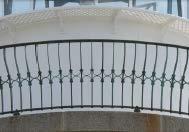
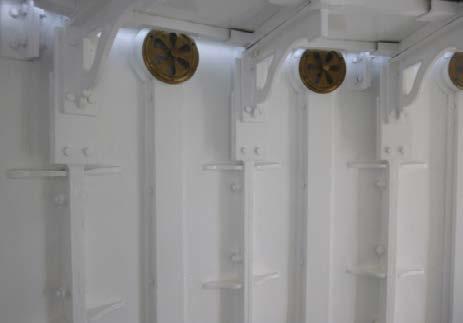
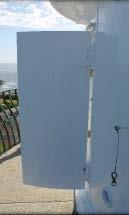
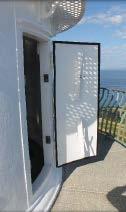
Lighthouse feature: Lantern floor
Description and condition
1880 floor of iron checker plate supported on rolled iron I section and channel beams built into the stone tower walls.
Holes indicate the former location of optic pedestal and clock.
Finish: painted
Condition: intact and sound
Integrity: high
Significance: high
Maintenance: keep in service, prepare and repaint at normal intervals
Rectification: works none
Heritage significance: High
The lantern floor is both an original and essential part of the lighthouse – exhibiting one style of late-19th century lighthouses (criterion a, criterion d).
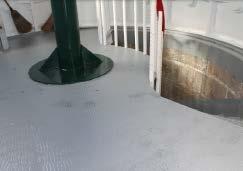
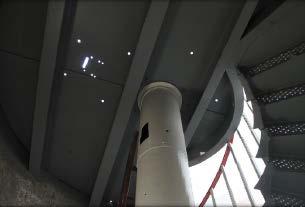
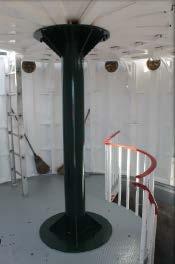
Lighthouse feature: Light source
Description and condition
Vega VRB-25 beacon.
Condition: not assessed
Integrity: medium
Significance: low
Maintenance: not assessed
Rectification works: none
Heritage significance: Low
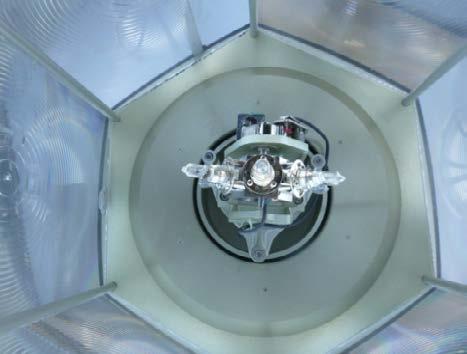
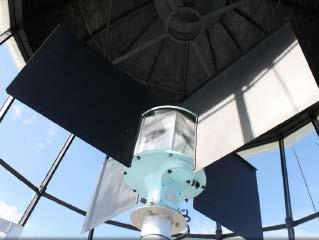
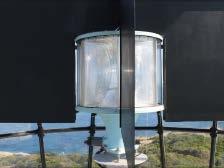
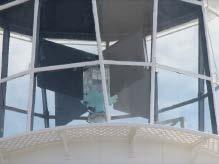
Lighthouse feature: Pedestal
Description and condition
Recent welded tubular aluminium post.
Finish: bare metal
Condition: intact and sound
Integrity: medium
Significance: low
Maintenance: none
Rectification: works none
Heritage significance: Low
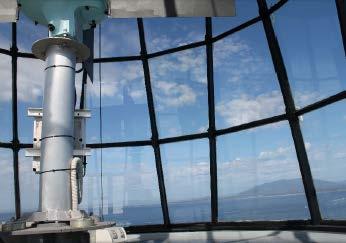
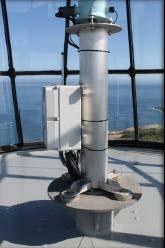
Lighthouse feature: Balcony floor
Description and condition
1880 granite slab floor, supported on the stone tower wall and cornice. Resilient joint caulking.
Finish: bare stone
Condition: intact and sound
Integrity: high
Significance: high
Maintenance: keep in service, replace joint caulking at normal intervals
Rectification works: none
Heritage significance: High
The balcony floor is both an original and essential part of the lighthouse – exhibiting one style of late-19th century lighthouses (criterion a, criterion d).
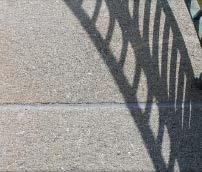
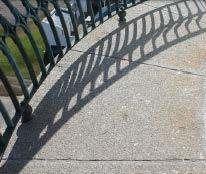
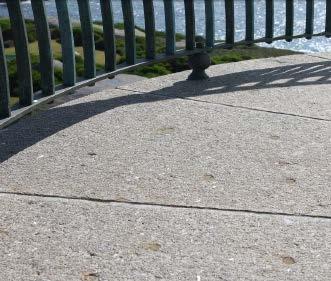
Lighthouse feature: Balcony balustrade
Description and condition
1880 gunmetal railing, with closely spaced balusters of rectangular section and curved profile, cruciform stiffeners bolted to balusters, rectangular bottom rail, half-round top rail, turned bulbous fixing bolts at bottom.
Finish: bare metal
Condition: intact and sound
Integrity: high
Significance: high
Maintenance: keep in service
Rectification works: none
Heritage significance: High
The balcony balustrade is both an original and essential part of the lighthouse – exhibiting one style of late-19th century lighthouses (criterion a, criterion d).
The balcony balustrade contributes to the aesthetic value of the lighthouse (criterion e).
The balcony balustrade demonstrates fine elements of design and craftsmanship (criterion f).
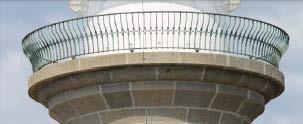
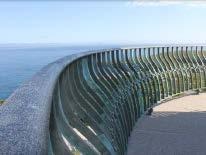
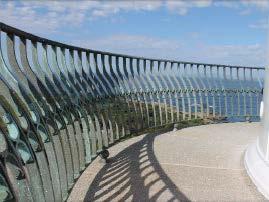
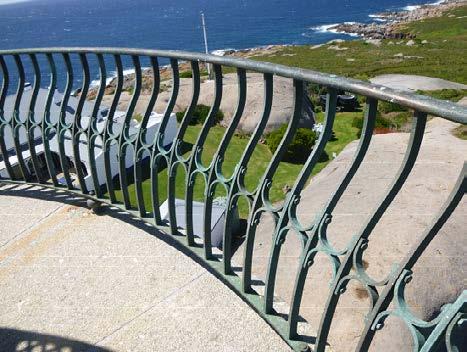
Lighthouse feature: Walls
Description and condition
1880 walls of granite with finely punched faces and drafted margins, inside and out.
Finish: bare stone outside, window reveals painted, formerly painted or lime washed inside
Condition: intact and sound
Integrity: high
Significance: high
Maintenance: keep in service, maintain painted window reveals, do not paint other interior parts
Rectification works: none
Heritage significance: High
The tower walls are both original and essential parts of the lighthouse – exhibiting one style of late-19th century lighthouses (criterion a, criterion d).
The granite stonework of the tower walls contribute to the aesthetic value of the lighthouse (criterion e).
The tapering tower walls demonstrate fine elements of design and craftsmanship (criterion f).



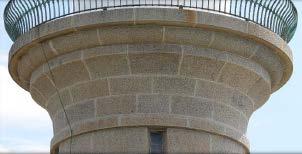
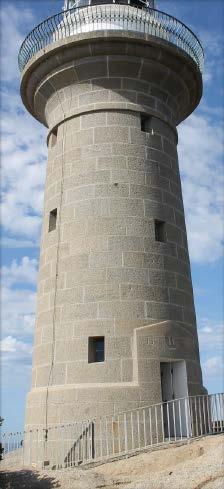
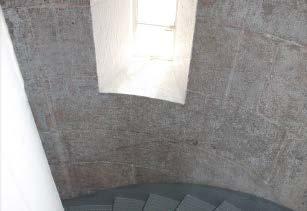
Lighthouse feature: Windows
Description and condition
1880 windows with gunmetal casement sashes, hinges, latches and frames, built into stone walls.
Finish: frames and sashes: painted glass: clear
Condition: intact and sound
Integrity: high
Significance: high
Maintenance: keep in service, prepare and repaint at normal intervals
Rectification works: none
Heritage significance: High
The windows are both original and essential parts of the lighthouse – exhibiting one style of late-19th century lighthouses (criterion a, criterion d).
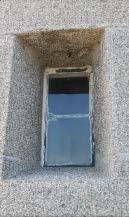
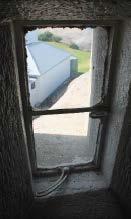
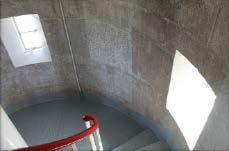
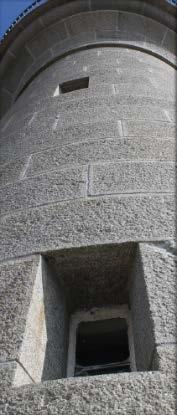
Lighthouse feature: Door
Description and condition
1880 door opening with external stone architrave with royal insignia and date 1881.
Two timber framed and sheeted door leaves hung on butt hinges in timber frame. Secured with two hasps and staples with padlocks.
Finish: painted
Condition: sound and intact
Integrity: high
Significance: high
Maintenance: keep in service, prepare and repaint at normal intervals
Rectification works: none
Heritage significance: High
The tower door is both an original and essential part of the lighthouse (criterion a).
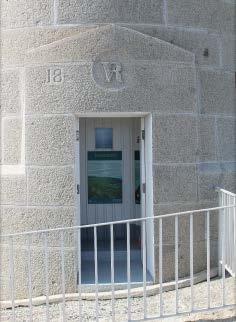
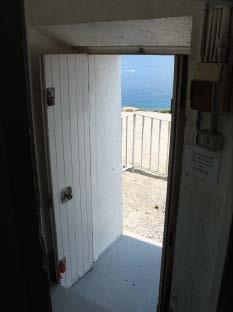

Lighthouse feature: Stairs
Description and condition
1880 geometric stair with cast iron treads attached to the tower walls. Wrought iron handrail and stanchions.
Finish: painted
Condition: intact and sound
Integrity: high
Significance: high
Maintenance: keep in service, prepare and repaint at normal intervals
Rectification: works none
Heritage significance: High
The internal tower stairs are both an original and essential part of the lighthouse (criterion a)
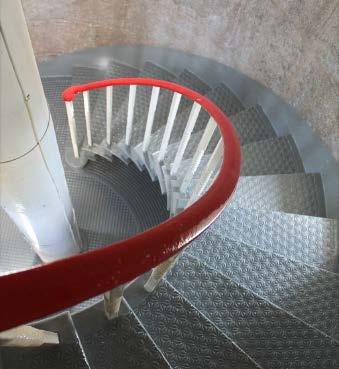
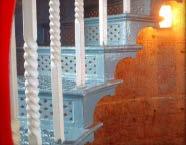
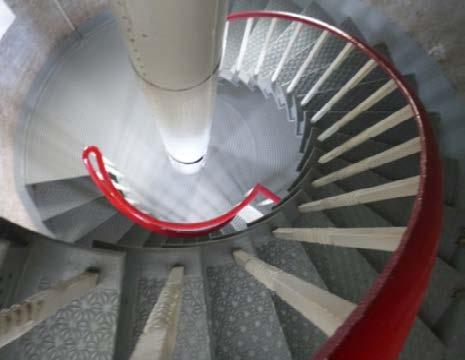
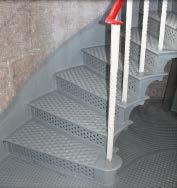
Lighthouse feature: Ground floor
Description and condition
1880 concrete slab.
Finish: painted
Condition: intact and sound
Integrity: high
Significance: high
Maintenance: keep in service
Rectification works: none
Heritage significance: High
The ground floor is an original and essential part of the lighthouse (criterion a).
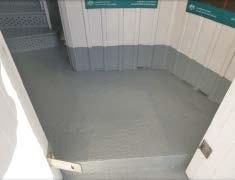
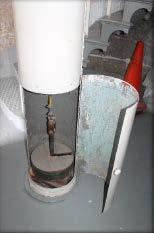
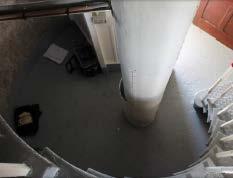
Lighthouse feature: Weight tube
Description and condition
1880 riveted iron tube in the centre of the tower, between the lantern floor and the ground floor.
Finish: painted
Condition: intact and sound
Integrity: high
Significance: high
Maintenance: preserve; prepare and repaint at normal intervals
Rectification works: none
Heritage significance: High
The weight tube is both an original and essential part of the lighthouse (criterion a).
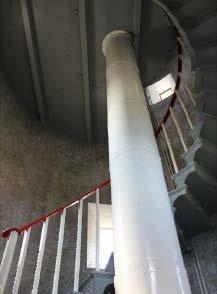
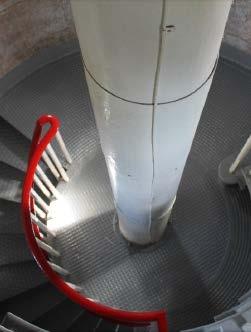
Lighthouse feature: Entrance vestibule
Description and condition
1880 timber framed, sheeted and ceiled wind lock vestibule, fitted with timber four-panel door.
Finish: painted
Condition: intact and sound
Integrity: high
Significance: high
Maintenance: keep in service; prepare and repoint at normal intervals
Rectification works: none
Heritage significance: High
The entrance vestibule is both an original and essential part of the lighthouse (criterion a).
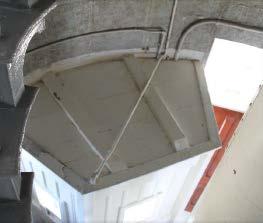
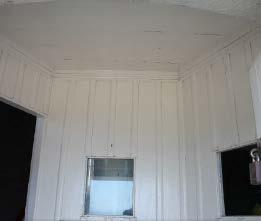
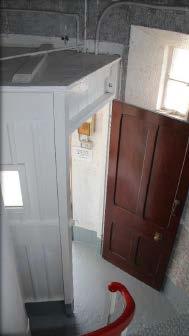
Lighthouse feature: Walkway / walkway stairs
Description and condition
1880 stone stair from keepers’ quarters area up to the base of the tower. Recent concrete path and aluminium railing.
Condition: intact and sound
Integrity: high
Significance: stair: high; railing: low
Maintenance: none
Rectification works: none
Heritage significance: High
The walkway stairs are both an original and essential part of the lighthouse (criterion a).
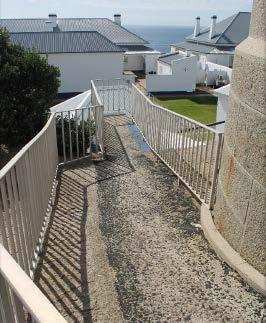
Lighthouse feature: Solar panels
Description and condition
14 solar panels on aluminium frame on concrete base, near the base of the tower, beside the much larger solar array used by the NPWS.
Two cabinets containing batteries and control equipment at the rear of solar array.
Condition: sound
Integrity: high
Significance: low
Maintenance: none
Rectification works: none
Heritage significance: Low
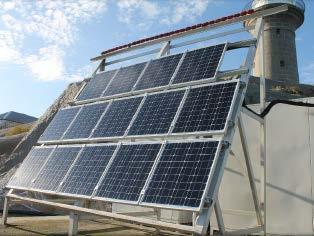
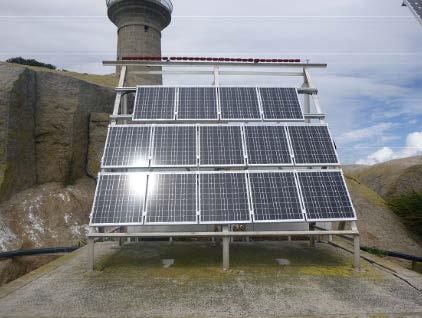
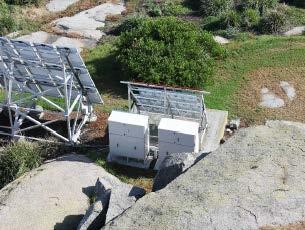
4.2 Related object or associated AMSA artefact
There are no AMSA registered artefacts.
4.3 Comparative analysis
The South Solitary Island Lighthouse, first lit in 1880, bears the closest resemblance to the Montague Island Lighthouse in design and style.
Designed by James Barnet, South Solitary Island Lighthouse stands as a mass concrete structure. Similar to Montague Island, South Solitary’s cylindrical tower was originally constructed to be slightly tapered in design with an outwardly sloping gunmetal balcony railing fitted around a Chance Bros. lantern room. The two lighthouses also share similar fittings such as the geometric cast iron stairs located within the tower. The lighthouses were both originally fitted with 1st Order Chance Bros. optical assemblies.
Unlike Montague Island, South Solitary’s tower was painted white and the base of the tower was enclosed by a small annex which contained the oil store.
The close stylistic resemblances of Montague Island and South Solitary Island, built one year apart, are indicative of James Barnet’s vision for NSW’s ‘highway of lights’. Despite some variation between the designs, both of the isolated island towers represent late-19th century craftsmanship and technical achievement.
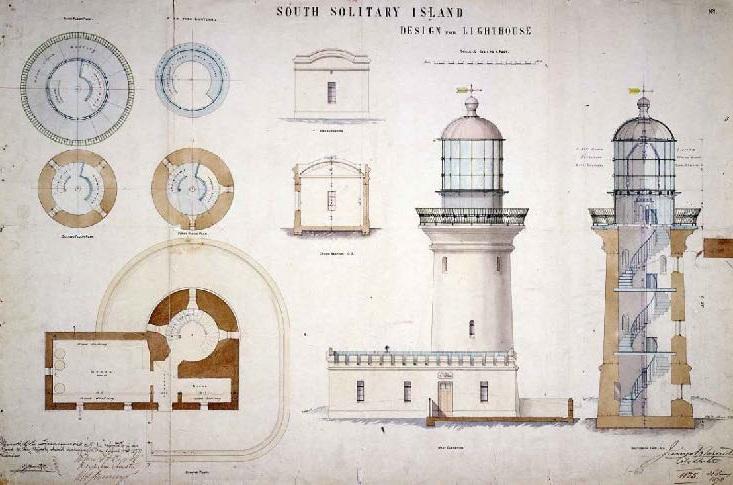 Figure 21. South Solitary Island Lighthouse elevation blueprint (James Barnet, 1878)
Figure 21. South Solitary Island Lighthouse elevation blueprint (James Barnet, 1878)